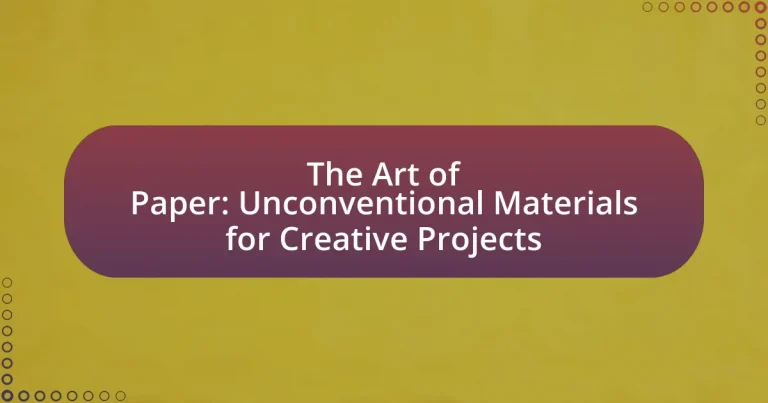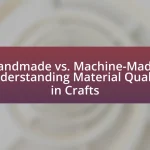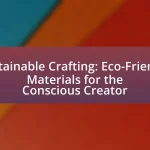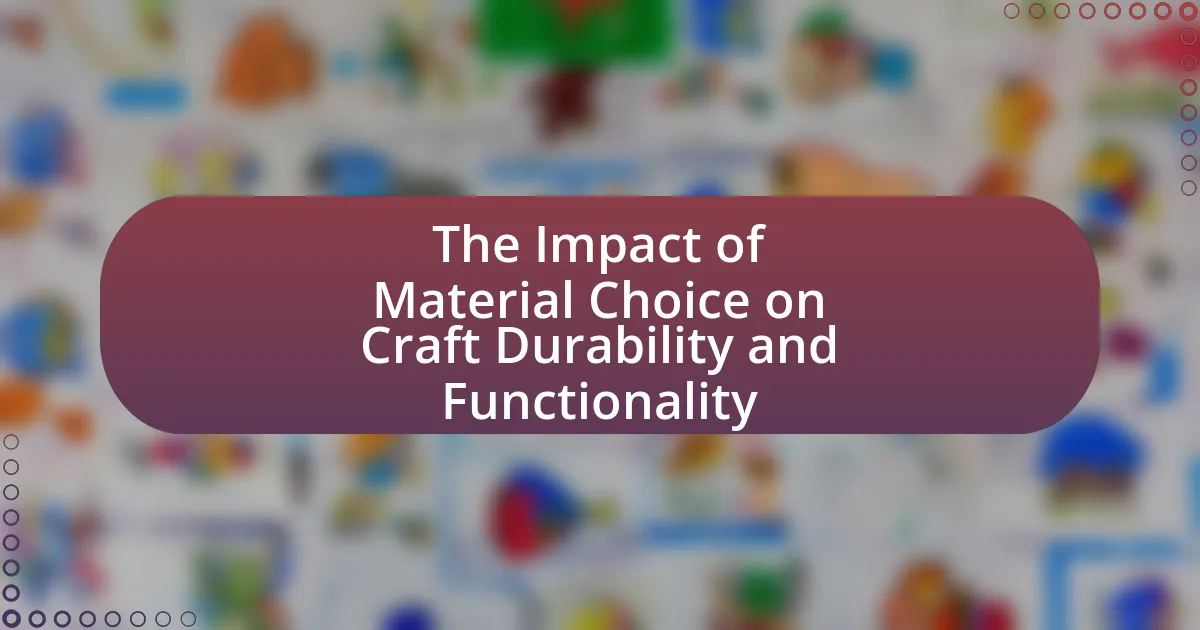The Art of Paper encompasses the creative use of paper as a medium for artistic expression, including techniques such as origami, paper cutting, and collage. This article explores the significance of paper art in creative projects, highlighting its versatility and accessibility. It examines how unconventional materials, such as fabric, metal, and natural elements, can enhance paper art by introducing unique textures and visual effects. Additionally, the article discusses key techniques, historical contexts, and the impact of sustainability on the art of paper, providing insights for both beginners and experienced artists looking to innovate within this medium.
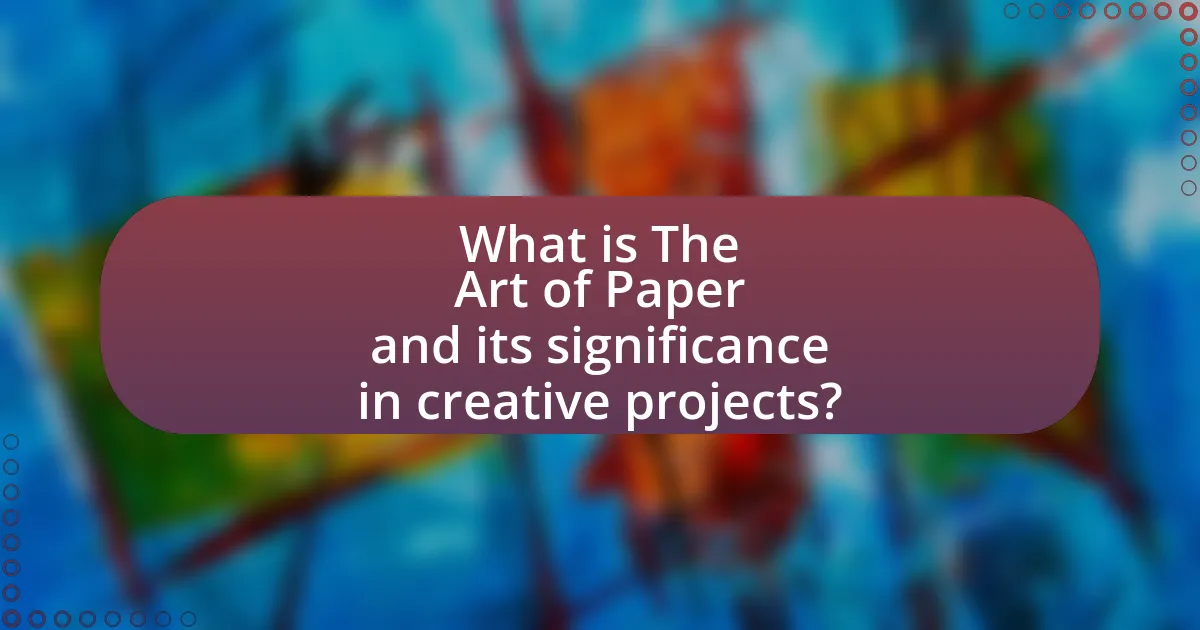
What is The Art of Paper and its significance in creative projects?
The Art of Paper refers to the creative practice of using paper as a medium for artistic expression, encompassing techniques such as origami, paper cutting, and collage. Its significance in creative projects lies in its versatility, accessibility, and ability to convey complex ideas through visual storytelling. For instance, artists like Robert Sabuda have popularized pop-up books, showcasing how paper can create dynamic three-dimensional experiences. Additionally, paper’s tactile qualities and wide range of textures allow for innovative designs, making it a favored choice among designers and crafters.
How can unconventional materials enhance the art of paper?
Unconventional materials can enhance the art of paper by introducing unique textures, colors, and structural properties that traditional paper lacks. For instance, incorporating materials like fabric, metal, or organic elements can create mixed-media artworks that engage viewers through tactile and visual diversity. Research shows that artists using unconventional materials often report increased creativity and innovation in their projects, as these materials challenge conventional boundaries and inspire new techniques. Additionally, the use of recycled or upcycled materials not only promotes sustainability but also adds a narrative layer to the artwork, making it more meaningful and contextually rich.
What types of unconventional materials are commonly used in paper art?
Unconventional materials commonly used in paper art include fabric, metal, plastic, and natural elements like leaves and flowers. Artists often incorporate fabric to add texture and color, while metal can be used for intricate designs or structural support. Plastic materials, such as plastic bags or wrappers, are repurposed to create unique visual effects. Additionally, natural elements like dried leaves and flowers enhance the organic aesthetic of paper art. These materials expand the creative possibilities and allow artists to explore new dimensions in their work.
How do these materials influence the texture and appearance of paper projects?
Unconventional materials significantly influence the texture and appearance of paper projects by introducing unique tactile qualities and visual effects. For instance, incorporating materials like fabric, metal foils, or natural elements such as leaves can create varied surface textures, enhancing the dimensionality of the paper. Research indicates that the use of textured materials can evoke different sensory responses, making the final product more engaging. Additionally, the color and pattern of these materials can alter the visual appeal, as seen in projects that utilize dyed or patterned fabrics, which can add depth and interest to the overall design.
Why is the art of paper considered a unique form of creativity?
The art of paper is considered a unique form of creativity because it allows for diverse expressions through various techniques such as origami, papercutting, and collage. These methods enable artists to manipulate a single medium into intricate designs, showcasing versatility and innovation. For instance, origami transforms flat sheets into three-dimensional sculptures, demonstrating the potential of paper to convey complex ideas and emotions. Additionally, the accessibility of paper as a material fosters experimentation, making it a popular choice among artists of all skill levels. This combination of technique, versatility, and accessibility solidifies paper art’s distinct position in the creative landscape.
What historical contexts have shaped the evolution of paper art?
The evolution of paper art has been shaped by various historical contexts, including the invention of paper in China during the Han Dynasty around 105 CE, which revolutionized artistic expression. The spread of paper-making techniques along the Silk Road facilitated the exchange of ideas and styles, influencing cultures in the Middle East and Europe. The introduction of woodblock printing in the 8th century further advanced paper art by allowing for mass reproduction of images and texts, leading to the development of intricate designs and techniques in Japan, such as origami and ukiyo-e. The Industrial Revolution in the 18th and 19th centuries also played a crucial role, as mechanized paper production made paper more accessible, enabling artists to experiment with new forms and styles. These historical milestones collectively contributed to the diverse practices and innovations in paper art seen today.
How does paper art differ from other artistic mediums?
Paper art differs from other artistic mediums primarily in its unique properties and versatility, allowing for a wide range of techniques such as folding, cutting, and layering. Unlike traditional mediums like paint or clay, paper can be easily manipulated and transformed, enabling artists to create intricate designs and three-dimensional structures. The lightweight nature of paper also facilitates portability and accessibility, making it a favored choice for both amateur and professional artists. Additionally, paper art often emphasizes sustainability, as it can be made from recycled materials, which is less common in other artistic mediums.
What are the key techniques used in the art of paper?
The key techniques used in the art of paper include origami, paper cutting, paper mâché, and collage. Origami involves folding paper into intricate designs, which can range from simple shapes to complex figures, demonstrating precision and creativity. Paper cutting is the technique of creating images or patterns by cutting shapes from paper, often resulting in delicate and detailed artwork. Paper mâché combines paper with a binding agent, such as glue or starch, to create three-dimensional forms, allowing for sculptural expressions. Collage involves assembling various paper pieces to create a unified artwork, showcasing texture and color diversity. Each of these techniques has historical significance and has been utilized by artists worldwide to explore the versatility of paper as a medium.
How can folding and cutting techniques transform paper into art?
Folding and cutting techniques can transform paper into art by enabling the creation of intricate designs and three-dimensional structures. These methods, such as origami and paper cutting, allow artists to manipulate flat sheets into complex forms, enhancing visual appeal and depth. For instance, origami has been shown to improve spatial reasoning skills, as evidenced by studies from the University of California, which highlight its educational benefits. Additionally, paper cutting has historical significance in cultures worldwide, such as Chinese paper cutting, which dates back to the 6th century and showcases the artistic potential of this medium. Thus, through folding and cutting, artists can elevate paper from a simple material to a dynamic art form.
What role does layering play in creating depth in paper projects?
Layering is essential in creating depth in paper projects as it adds dimensionality and visual interest. By stacking multiple layers of paper, artists can create shadows and highlights that enhance the perception of depth. For instance, using varying thicknesses and colors of paper allows for a more dynamic composition, where the foreground elements appear closer and the background elements recede. This technique is widely utilized in paper crafting, such as in shadow boxes and 3D paper sculptures, where the interplay of layers can significantly transform a flat surface into a multi-dimensional artwork.
How can one transition from traditional to unconventional materials in paper art?
To transition from traditional to unconventional materials in paper art, one should start by experimenting with various non-paper elements such as fabric, metal, or plastic. This approach allows artists to explore new textures and forms, enhancing their creative expression. For instance, incorporating materials like recycled plastics can add durability and unique visual effects, while using textiles can introduce softness and depth. Artists can also look into historical practices, such as the use of handmade paper from alternative fibers, which has been documented in various cultures, showcasing the versatility of materials beyond conventional paper.
What challenges might artists face when using unconventional materials?
Artists face several challenges when using unconventional materials, including issues related to material compatibility, durability, and audience perception. The use of non-traditional items may lead to difficulties in achieving desired artistic effects, as these materials often behave differently than conventional art supplies. For instance, organic materials like leaves or fabric may degrade over time, impacting the longevity of the artwork. Additionally, unconventional materials can provoke skepticism or misunderstanding from audiences, who may not recognize the artistic value or intent behind the use of such items. This challenge is supported by studies indicating that audience engagement can be influenced by familiarity with materials, as seen in research published in the Journal of Arts Management, Law, and Society, which highlights how traditional materials are often more readily accepted in the art community.

What are some innovative examples of paper art using unconventional materials?
Innovative examples of paper art using unconventional materials include the use of recycled plastic, metal foils, and organic materials like leaves and flowers. Artists such as Yuken Teruya create intricate sculptures from discarded paper bags, transforming them into delicate tree forms, while others like Jen Stark utilize vibrant layers of cut paper combined with metallic elements to produce three-dimensional works. Additionally, the incorporation of natural elements, such as dried flowers and leaves, into paper art not only enhances aesthetic appeal but also promotes sustainability, as seen in the works of artists who blend traditional paper techniques with eco-friendly practices. These examples demonstrate the versatility of paper art when combined with unconventional materials, pushing the boundaries of creativity and environmental consciousness.
How have contemporary artists redefined paper art with new materials?
Contemporary artists have redefined paper art by incorporating unconventional materials such as textiles, plastics, and digital media. This integration allows for innovative textures, durability, and interactive elements that traditional paper alone cannot provide. For instance, artists like El Anatsui use discarded materials, including bottle caps and aluminum, to create intricate paper-like sculptures, demonstrating how repurposed items can transform the perception of paper art. Additionally, the use of digital technology enables artists to create layered, dynamic works that challenge the static nature of traditional paper art, as seen in the works of artists like Jen Stark, who combines paper cutting with digital animation. These approaches not only expand the aesthetic possibilities of paper art but also engage with contemporary themes of sustainability and technology.
What are some notable projects that showcase unconventional paper art?
Notable projects that showcase unconventional paper art include the “Paper Sculptures” by artist Peter Callesen, who creates intricate three-dimensional works from a single sheet of paper, often incorporating themes of transformation and fragility. Another significant project is “The Paper Project” by artist Yuken Teruya, where he transforms fast-food bags into delicate tree sculptures, highlighting the contrast between nature and consumerism. Additionally, the “Paper Jungle” installation by artist Kumi Yamashita features shadows created from cut paper, demonstrating the interplay of light and form. These projects exemplify innovative uses of paper, pushing the boundaries of traditional paper art.
How do these projects inspire others in the creative community?
These projects inspire others in the creative community by showcasing innovative uses of paper that challenge traditional artistic boundaries. For instance, artists like El Anatsui and his use of discarded materials, including paper, demonstrate how unconventional materials can create impactful visual narratives. This approach encourages other creatives to explore sustainability and resourcefulness in their own work, fostering a culture of experimentation and collaboration. Additionally, workshops and exhibitions featuring these projects often highlight the transformative potential of paper, motivating artists to rethink their mediums and techniques, ultimately leading to a broader acceptance of diverse artistic expressions.
What role does sustainability play in the use of unconventional materials?
Sustainability is crucial in the use of unconventional materials as it promotes environmentally responsible practices and reduces waste. By utilizing materials such as recycled paper, plant-based fibers, or biodegradable substances, creators can minimize their ecological footprint. For instance, the use of recycled paper can save up to 60% of energy compared to producing new paper from trees, thereby conserving natural resources and reducing greenhouse gas emissions. This approach not only supports sustainable development but also encourages innovation in creative projects, leading to unique artistic expressions that align with environmental values.
How can artists source eco-friendly materials for their projects?
Artists can source eco-friendly materials for their projects by exploring local suppliers that specialize in sustainable products, such as recycled paper, organic inks, and biodegradable adhesives. Many art supply stores now offer eco-friendly options, and online platforms like Eco-Artists and Green Art supply lists provide curated selections of sustainable materials. Additionally, artists can participate in community exchanges or upcycling initiatives, which promote the reuse of materials, thus reducing waste. Research indicates that the global market for sustainable art supplies is growing, reflecting a rising demand for environmentally responsible options among artists.
What impact does using recycled materials have on the art of paper?
Using recycled materials significantly enhances the art of paper by promoting sustainability and creativity. The incorporation of recycled fibers reduces the demand for virgin materials, thereby conserving natural resources and minimizing environmental impact. For instance, the production of recycled paper uses about 60% less energy and 70% less water compared to traditional paper manufacturing processes. Additionally, artists can experiment with unique textures and colors that arise from various recycled sources, leading to innovative artistic expressions. This practice not only fosters environmental responsibility but also encourages a diverse range of artistic techniques and styles, enriching the overall landscape of paper art.
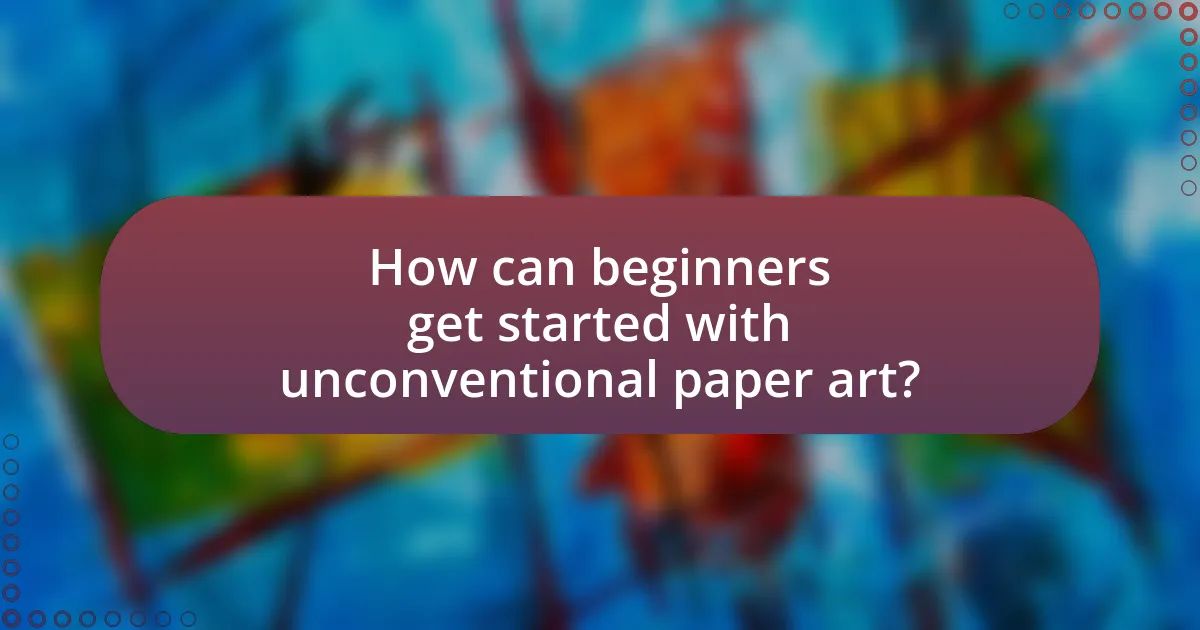
How can beginners get started with unconventional paper art?
Beginners can get started with unconventional paper art by exploring various materials such as recycled paper, cardboard, and specialty papers like handmade or textured options. Engaging in simple projects, such as paper sculptures or collages, allows beginners to experiment with techniques like folding, cutting, and layering. Resources like online tutorials and workshops provide structured guidance, while communities on social media platforms offer inspiration and feedback. According to a study published in the Journal of Creative Arts, engaging in unconventional art forms enhances creativity and problem-solving skills, making it a beneficial pursuit for beginners.
What essential tools and materials are needed for beginners?
Beginners in the art of paper crafting need essential tools and materials such as scissors, glue, a cutting mat, and various types of paper. Scissors are necessary for precise cutting, while glue is essential for adhering pieces together. A cutting mat protects surfaces and provides a stable base for cutting. Different types of paper, including cardstock, origami paper, and recycled materials, allow for diverse creative projects. These tools and materials form the foundation for exploring various techniques and styles in paper art.
How can beginners experiment with different techniques and materials?
Beginners can experiment with different techniques and materials by engaging in hands-on projects that incorporate various forms of paper and unconventional materials. For instance, they can start by creating collages using recycled paper, fabric scraps, or natural elements like leaves, which allows them to explore texture and layering. Additionally, they can try techniques such as paper marbling or origami, which introduce them to different folding and coloring methods. Research indicates that hands-on experimentation enhances creativity and skill development, as seen in studies by the National Endowment for the Arts, which highlight the benefits of artistic exploration in educational settings.
What resources are available for learning about unconventional paper art?
Online platforms such as Skillshare and Udemy offer courses specifically focused on unconventional paper art techniques. These platforms provide video tutorials and project-based learning, allowing users to explore various styles and methods. Additionally, books like “Paper Sculpture: A Step-by-Step Guide” by David G. Smith and “The Art of Paper: Techniques and Projects” by Jennifer McGuire serve as valuable resources, offering detailed instructions and inspiration for artists. Furthermore, social media platforms like Instagram and Pinterest showcase a plethora of artists and their work, providing visual inspiration and community engagement for those interested in unconventional paper art.
What tips can help artists successfully integrate unconventional materials into their projects?
Artists can successfully integrate unconventional materials into their projects by experimenting with various textures and forms, allowing for innovative expression. This approach encourages artists to explore the unique properties of materials such as recycled items, natural elements, or industrial components, which can lead to unexpected results. For instance, using materials like cardboard or fabric can add depth and dimension to a piece, while incorporating found objects can create a narrative or thematic resonance. Additionally, artists should consider the compatibility of these materials with traditional mediums, ensuring that they can be effectively combined without compromising the integrity of the artwork. This method has been validated by numerous contemporary artists who have gained recognition for their innovative use of non-traditional materials, demonstrating that such integration can enhance creativity and originality in art.
